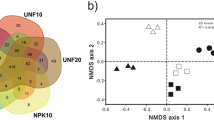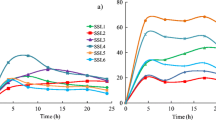Abstract
Soils exposed to long-term contamination with hydrocarbons may present extreme challenges to maintain the biological resilience to the stress. To elucidate the relationships between the initial event of contamination and the responsiveness to the stress, we investigated the extent of the microbial resilience of biological functions from two contaminated soils sampled from a petrochemical area (S1, underwent diffuse hydrocarbon contamination, and S2, from a land farming unit where an alkaline petrochemical sludge was treated) after the Cd, saline, and acid stresses. Both contaminated soils were characterized by low organic matter content compared with a pristine soil. Although similar Shannon diversity index and heterotrophic bacterial count were observed, different bacterial community structures (PCR-DGGE) and less enzymatic activities characterized the contaminated soils. Particularly, functional diversity determined by Biolog EcoPlates™ was not detected in S2 soil. Only the S1 soil showed resilience of the enzymatic activities and functional diversity, suggesting the presence of a well-adapted microbial community able to face with the stresses. The S2 was the most disturbed and less responsive soil. However, an increase in the functional diversity was evidenced after acidification, and it is possible to correlate this responsiveness with the sludge properties treated in the land farming unit. In addition, if the selected stress can reverse the soil condition provoked for the first disturbance, responsiveness could be expected.




Similar content being viewed by others
References
Chaignon, V., Sanchez-Neira, I.,Hermann, Jaillard, P., Hinsinger, B., Copper, P. (2003). bioavailability and extractability as related to chemical properties of contaminated soils from a vine-growing area. Environmental Pollution, 123, 229–238.
Classen, A. T., Boyle, S. I., Haskins, K. E., Overby, S. T., & Hart, S. C. (2003). Community-level physiological profiles of bacteria and fungi: plate type and incubation temperature influences on contrasting soils. FEMS Microbiology Ecology, 44, 319–328.
Degens, B. P., Schipper, L. A., Sparling, G. P., & Duncan, L. C. (2001). Is the microbial community in a soil with reduced catabolic diversity less resistant to stress or disturbance? Soil Biology & Biochemistry, 33, 1143–1153.
Del Panno, M. T., Morelli, I. S., Engelen, B., & Berthe-Corti, L. (2005). Effect of petrochemical sludge concentrations on microbial communities during soil bioremediation. FEMS Microbiology Ecology, 53, 305–316.
Fromin, N., Hamelin, J., Tarnawski, S., Roesti, D., Jourdain-Miserez, K., Forestier, N., Teyssier-Cuvelle, S., Gillet, F., Aragno, M., & Rossi, P. (2002). Statistical analysis of denaturing gel electrophoresis (DGE) fingerprinting patterns. Environmental Microbiology, 4, 634–643.
Griffiths, B. S., & Philippot, L. (2013). Insights into the resistance and resilience of the soil microbial community. FEMS Microbiology Review, 37, 112–129.
Griffiths, B. S., Bonkowski, M., Roy, J., & Ritz, K. (2001). Functional stability, substrate utilisation and biological indicators of soils following environmental impacts. Applied Soil Ecology, 16, 49–61.
Ibarrolaza, Coppotelli, B. M., Del Panno, M. T., Donati, E. R., & Morelli, I. S. (2009). A Dynamics of microbial community during bioremediation of phenanthrene and chromium (VI)-contaminated soil microcosms. Biodegradation, 20, 95–107.
Insam, H. (1997). A new set of substrates proposed for community characterization in environmental samples. In H. Insam & A. Rangger (Eds.), Microbial community: functional versus structural approaches (pp. 259–260). Berlin: Springer.
Kandeler, E., & Gerber, H. (1988). Short-term assay of soil urease activity using colorimetric determination of ammonium. Biology and Fertility of Soils, 6, 68–72.
Kelly, J. J., Häggblom, M., & Tate, R. L., III. (1999). Effects of the land application of sewage sludge on soil heavy metal concentration and soil microbial communities. Soil Biology & Biochemistry, 31, 1465–1470.
Khan, S., Cao, Q., Hesham, A., Xia, Y., & He, J. (2007). Soil enzymatic activities and microbial community structure with different application rates of Cd and Pb. Journal of Environmental Sciences, 19, 834–840.
Knight, B. P., Mc Grath, S., & Chaudri, A. M. (1997). Biomass carbon measurements and substrate utilization patterns of microbial populations from soils amended with cadmium, copper, or zinc. Applied Environmental Microbiology, 63, 39–43.
Margesin, R., Feller, G., Hämmerle, M., Stegner, U., & Schinner, F. (2002). A colorimetric method for the determination of lipase activity in soil. Biotechnology Letters, 24, 27–33.
Morelli, I. S., Vecchioli, G. I., Del Panno, M. T., Garré, M. I., Costanza, O. R., & Painceira, M. T. (1995). Assessment of the toxic potential of hydrocarbon containing sludges. Environmental Pollution, 89, 131–135.
Nielsen, N.M., Winding, A., Binnerup, S., Hansen, B.M., & Kroer, N. (2002). Microorganisms as indicators of soil health. National Environmental Research Institute (NERI). Technical report No. 388.
Pandey, J., Chauhan, A., & Jain, K. (2009). Integrative approaches for assessing the ecological sustainability of in situ bioremediation. FEMS Microbiology Review, 33, 324–375.
Shi, W., Bischoff, M., Turco, R., & Konopka, A. (2005). Microbial catabolic diversity in soils contaminated with hydrocarbons and heavy metal. Environmental Science & Technology, 39, 1974–1979.
Smeda, A., & Zyrnicki, W. (2002). Application of sequential extraction and the ICP-AES method for study of the partitioning of metals in fly ashes. Microchemical Journal, 72, 9–16.
Sparks, D. L. (1996). Methods of soil analysis: Part 3. Chemical methods and processes. In D. L. Sparks (Ed.), Book Series 5. Madison: Soil Science Society of America.
Steenwerth, J. L., Jackson, L. E., Calderón, F. J., Scow, K. M., & Rolston, D. E. (2005). Response of microbial community composition and activity in agricultural and grassland soils after a simulated rainfall. Soil Biology & Biochemistry, 37, 2249–2262.
Tessier, A., Campbell, P. G. C., Auclair, J. C., & Bison, M. (1979). Sequential extraction procedure for the speciation of particulate trace metals. Chemistry, 51, 844–851.
Thavamani, P., Malik, S., Beer, M., Megharaj, M., & Naidu, R. (2012). Microbial activity and diversity in long-term mixed contaminated soils with respect to polyaromatic hydrocarbons and heavy metals. Journal of Environmental Management, 99, 10–17.
Tobor-Kaplon, M. A., Bloem, J., & de Ruiter, P. C. (2006). Functional stability of microbial communities from long-term stressed soils to additional disturbance. Environmental Toxicology & Chemistry, 25, 1993–1999.
Vecchioli, G., Del Panno, M. T., & Painceira, M. T. (1990). Use of selected autochthonous soil bacteria to enhance degradation of hydrocarbons in soil. Environmental Pollution, 67, 249–258.
Verchot, L. V., & Borelli, T. (2005). Application of para-nitrophenol (pNP) enzyme assays in degraded tropical soils. Soil Biología & Biochemistry, 37, 625–633.
Viñas, M., Sabatè, J., Espuny, M. J., & Solanas, A. M. (2005). Bacterial community dynamics and polycyclic aromatic hydrocarbon degradation during bioremediation of heavily creosote-contaminated soil. Applied Environmental Microbiology, 71, 7008–7018.
Vivas, A., Moreno, B., del Val, C., Macci, C., Masciandaro, G., & Benitez, E. (2008). Metabolic and bacterial diversity in soils historically contaminated by heavy metals and hydrocarbons. Journal Environmental Monitoring, 10, 1287–1296.
Wrenn, B. A., & Venosa, A. D. (1996). Selective enumeration of aromatic and aliphatic hydrocarbon degrading bacteria by a most-probable-number procedure. Canadian Journal of Microbiology, 42, 252–258.
Yin, Y., Impellitteri, C.A., You, S.J., Allen, H.E. (2002). The importance of organic matter distribution and exact soil: solution ratio on the desorption of heavy metals from soils. Science of the Total Environment, 287, 107–119.
Acknowledgments
This research was partially supported by the Agencia Nacional de Promoción Científica y Tecnológica (ANPCyT) (PICT 2010–00366). Pessacq J. is doctoral fellow of CONICET; Medina R. is a doctoral fellow of ANPCyT; Morelli I.S. is research member of CIC-PBA; and Del Panno M.T. is research member of Universidad Nacional de La Plata.
Author information
Authors and Affiliations
Corresponding author
Rights and permissions
About this article
Cite this article
Pessacq, J., Medina, R., Terada, C. et al. Assessment of the Responsiveness to Different Stresses of the Microbial Community from Long-Term Hydrocarbon-Contaminated Soils. Water Air Soil Pollut 226, 20 (2015). https://doi.org/10.1007/s11270-014-2262-9
Received:
Accepted:
Published:
DOI: https://doi.org/10.1007/s11270-014-2262-9




